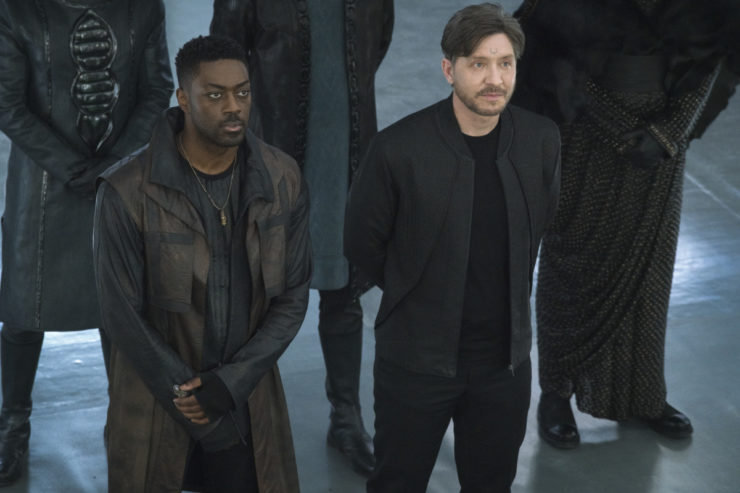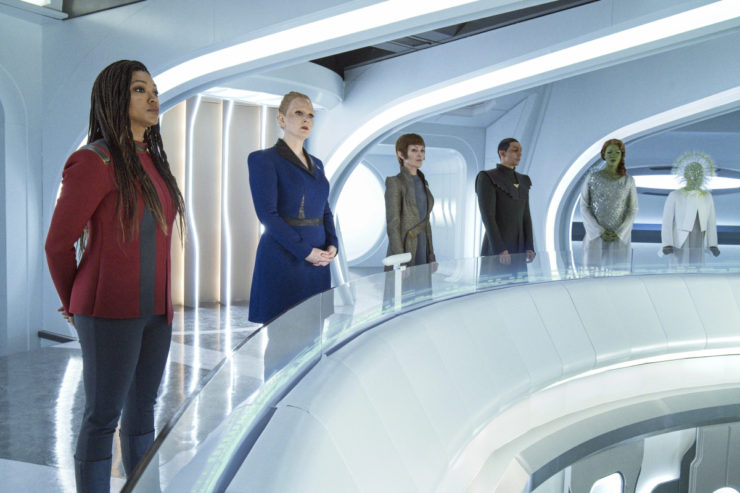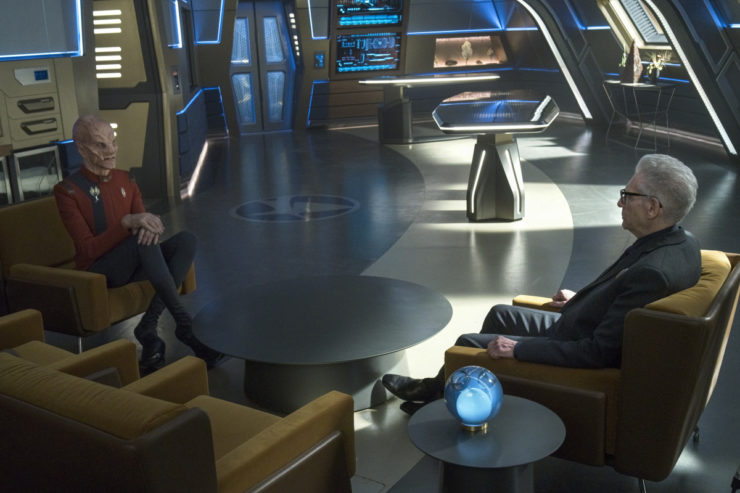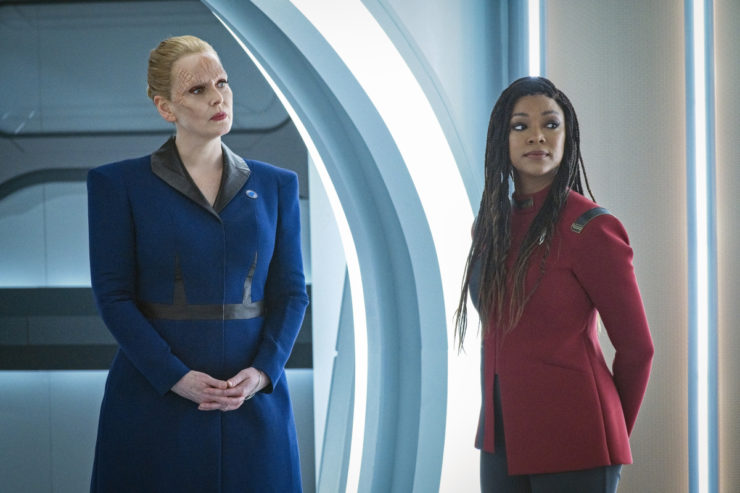Back in 2005, I wrote a Star Trek novel called Articles of the Federation, which was about a year in the life of the Federation President. The book is entirely talking heads, with virtually every scene being people sitting in a room having a conversation. Which is what politics is, after all.
One of the criticisms that many have leveled against the current crop of Trek shows on Paramount+ is that they favor action-adventure and big ‘splosions over quieter stories and plotlines. I’ve even raised that criticism a few times, notably in the conclusion of the previous season.
“…But to Connect,” which also serves as a “mid-season finale” of sorts while the show takes a one-month break for more episodes of Prodigy, is also entirely a talking-heads story, and it’s fantastic.
There are two sets of conversations going on here. The first is the assembly gathered by President Rillak, which has people from all across the galaxy—and yes, it’s the galaxy, Stamets specifically says “all four quadrants” at one point, meaning we’ve got Gamma and Delta Quadrant representatives, as well as the expected Alpha and Beta. They’re going to discuss what to do once they determine the location of Species 10C (the designation they’ve given to the creators of the DMA).
There are some familiar faces at the assembly: Lee’U (Alex McCooeye), the emperor of the butterfly people we met at the top of “Kobayashi Maru,” General Ndoye (Phumzile Sitole) of what is now a united Earth and Titan, showing that Discovery‘s actions in “People of Earth” last year had a positive impact, both T’Rina (Tara Rosling, last seen in “All is Possible”) and Sta’Kiar (Giovanni Spina, last seen in “Choose to Live”) from Ni’Var, as well as Orions, Lurians, Andorians, Trill, Cardassians, Ferengi, etc.
And we’ve got some others, too, like Book and the triumphant return of Shawn Doyle as Tarka. Tarka has a proposal for the assembly, and it’s a very provocative one that provides a source of conflict in the episode.

Though it’s hardly the only source of conflict, as from the very beginning, there’s a disparity among the assembly in how to approach Species 10C. The conflict is primarily presented in another manner that has often been Trek’s approach, particularly in the original series with Spock vs. McCoy and Enterprise with Archer and Tucker vs. T’Pol and Soval: human emotion vs. Vulcan rationality. Ndoye is the first to advocate assembling a big-ass fleet to shove a quantum torpedo up Species 10C’s ass, while T’Rina and Sta’Kiar plea for communication and an attempt to make a peaceful first contact rather than risk more lives in an attack—an argument also supported by Burnham, a human raised on what was then called Vulcan.
The other conversation involves Zora, who sets up the secondary source of conflict in the episode: based on the data Discovery gathered last week, she has found the likely location of Species 10C.
Unfortunately, she’s decided to withhold that information because if she provides it, Discovery will go after them, and that would be incredibly dangerous. Zora’s growing emotions means that she cares deeply about the crew and wants to keep them safe. Being ordered by Burnham doesn’t change her position.
And so Kovich is sent to evaluate Zora and figure out what to do with her and hopefully convince her to give up the coordinates. But there’s another issue: an integrated piece of equipment can’t be sentient, so Kovich must figure out the disposition of Zora, including the possibility of removing her completely from Discovery, something she very much does not want.
Aiding Kovich in talking to Zora are Saru, Stamets, Adira, Gray, and Culber. It’s a fascinating continuation and evolution of the ongoing discussion about artificial intelligence that Trek has engaged in for its entire history, from Kirk out-logic-ing super-computers and androids on the original series to the characters of Data on TNG, the EMH on Voyager, and the various androids played by Isa Briones on Picard.
I particularly like that Stamets is the big holdout here, as he’s the one who has the biggest issue with a computer withholding information, at least partly based on their experiences with Control in season two. And ultimately what it comes down to is a matter of trust. The Discovery crew wants Zora to trust them that (a) they will do everything they can to keep themselves safe, but (b) they need this information to save a lot more lives. But it also means that they have to trust her in return.

The solution that they come up with is elegant and brilliant and I adore it. Integrated equipment can’t be sentient, but sentient beings can enlist in Starfleet. And so Zora is made part of the crew as an enlisted specialist. Besides giving Zora a role that fits her newfound state more than just being a tool, it also means what happened in this episode can’t happen as easily again. If she disobeys a direct order—as she does when Burnham orders her to reveal the coordinates and she declines—there are regulations in place to deal with such insubordination for Starfleet personnel. There’s even precedent for this, in terms of the aforementioned EMH, who also went from being a tool to officially being the chief medical officer of Voyager, though that was more of a gradual process.
(This gives us yet another way in which this era of Discovery is like Gene Roddenberry’s Andromeda, as the ship’s sentient computer, played by Lexa Doig, was a member of the crew of the Andromeda Ascendant.)
This is a much better solution than the one Zora herself proposes: a failsafe that would terminate Zora if she gets out of line again. That’s a horrid proposition, and one that nobody is comfortable with.
Speaking of horrid propositions, we have Tarka’s proposal to the assembly: a weapon that will destroy the DMA—but which uses an isolytic burst, a weapon that was established as being banned by the Khitomer Accords way back in Insurrection, a ban that still holds true eight centuries after that movie due to the irreparable damage to subspace that such weapons cause.
Buy the Book


Until the Last of Me
The two conversations come together in a beautifully written and filmed sequence, and much credit to writers Terri Hughes Barton & Carlos Cisco, director Lee Rose, and the editing crew for this. Because Rillak, as the person who called the assembly, must remain neutral, it’s left to Burnham to plead the case for an attempt at contact and gaining knowledge rather than going in with guns blazing. At the same time, Stamets is trying to find a way to trust Zora, and needs help getting there. Stamets’s emotional response to Zora’s growing sentience is one of fear, borne primarily of his experiences with Control, and he wants to find a way to get past that fear and choose to trust her.
The two speeches are masterfully intercut, with Burnham pleading for the assembly to make the very same emotional journey that Stamets is also struggling with: to not let fear rule the day.
In the end, Zora chooses to share the coordinates, and the assembly votes in favor of first contact. What I especially like is that Zora comes to her decision by a rational analysis of her emotional response, realizing that she didn’t factor the crew’s history of working to protect the greatest number of people possible into her decision.
But not everyone voted for first contact, obviously, and that gives us a rather nasty ending to what has been a very optimistic, hopeful, beautiful episode. Prior to the DMA bigfooting everything, Tarka had been working on producing another spore drive. He’s been able to re-create it, but you still need a navigator, a role that thus far only Stamets and Book are capable of providing. But that’s enough for Tarka to make off with it and install it on Book’s ship.
And so the episode ends with Book and Tarka buggering off to blow up the DMA anyhow.
I was worried that this was going to spell the end of Book and Burnham’s relationship—Book’s pointed commentary about consequences to Burnham in the assembly pointed to that—but in the end, he leaves Grudge with Burnham, along with a note saying he loves her, before black-alert-ing his way away with Tarka. They don’t agree, but it’s not enough to sunder the relationship, a level of maturity rarely seen in fictional characters, and it’s very nice to see.
This may be my favorite episode of Discovery to date precisely because it favors talking over fighting, ideals over cynicism, rationality over fear, and that most Star Trek of values, compassion over violence. Every performance here is strong: Doyle’s over-the-top snottiness in Tarka’s presentation. David Ajala’s facial expressions showing just how unhappy Book is with Burnham arguing the other side of this, as well as how much he passionately agrees with Ndoye and Tarka’s positions. Doug Jones continuing to be amazing as Saru acts as the calm voice of reason throughout the Zora plotline. David Cronenberg continuing to be direct and uncaring of niceties in favor of getting shit done as Kovich. Chelah Horsdal continuing to show Rillak as a very canny politician, using all the resources at her disposal, while Sitole and Rosling do magnificent work showing the two sides of the argument.

But the episode belongs to Anthony Rapp and Sonequa Martin-Green, who beautifully sell their concerns, and in particular I love how neither of them overplays their speeches. There’s real strength and conviction, but it’s not over the top.
There are some other bits of paperwork, including Saru flirting some more with T’Rina (they really do make an adorable couple), and Gray joining the Trill delegation to start his training as a Guardian, which provides us with the lovely scene of the group hug among Stamets, Culber, Adira, and Gray as he and Adira depart (Adira taking a week off to help Gray settle before they return to Discovery).
Ultimately, this brings the season to the halfway point on a very fitting note, with an episode that reinforces what Trek is all about. Best of all is that it does so with a minimum of bombast, and it’s a look I hope the show has the confidence to indulge in more often.
[Please note that comments will be temporarily closed over the holiday break, but will be open for discussion on Monday, January 3rd.]
Keith R.A. DeCandido wishes everyone a happy and safe new year.










